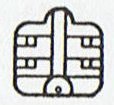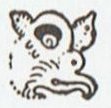2. The 13th son of Tu was Moko:
|
13 Moko |
Maroro |
Wakehau |
 |
 |
 |
| Eb7-8 |
Eb7-9 |
Eb7-10 |
| ko raua ka tutu |
ka tupu te rakau |
ka tu te niu |
 |
 |
 |
|
13 Mac |
Kankin |
Moan |
|
Toa in the central position of Eb7-8 is not exactly the same as that in front in Eb6-33, 11 glyphs earlier. Neither is manu rere in Eb6-33 the same bird as in Eb7-6. The sinking Sun at bottom of the 'tree' in Eb7-9 corresponds to the similarly sinking Sun at the bottom of the 'skeleton ribs'. |
The word moko means lizard (a creature moving quickly):
| Moko 1. Lizard; moko manu uru, figurine of a lizard (made of wood). 2. To throw oneself on something, to take quickly, to snatch; to flee into the depths (of fish); tagata moko, interloper, intruder, someone who seizes something quickly and swiftly, or cleverly intrudes somewhere; ka-moko ki te kai, ka-moko, ka-aaru, quickly grab some food, grab and catch. 3. To throw oneself upon someone, to attack: he-moko, he-reirei, to attack and kick. 4. Moko roa: to make a long line (of plantation); moko poto, to make a short line. 5. Ihu moko; to die out (a family of which remains only one male without sons); koro hakamao te mate o te mahigo, he-toe e-tahi tagata nó, ina aana hakaara, koîa te me'e e-kî-nei: ku-moko-á te ihu o te mahigo. when the members of family have died and there remains only one man who has no offspring, we say: ku-moko-á te ihu o te mahigo; to disappear (of a tradition, a custom), me'e ihu moko o te tagata o te kaiga nei, he êi, the êi is a custom no longer in use among the people of this island. Vanaga.
1. Lizard. P Pau., Mgv., Mq.: moko, id. Ta. moó, id. 2. To stun, to be dizzy. PS Sa.: mo'o, to be surprised. Hakamoko, to accomplish. Mokohi, grain, full-grown berry (mokoi); mokohi haraoa, grain. Mgv.: mokohe, food. Mokoimokoi, heart T, kidney. Mokomoko, sharp, pointed, slender, cape, headland; gutu mokomoko, pointed lips. Churchill.
Mgv.: mokora, a duck. Ta.: moora, id. Churchill. |
At autumn equinox, when Sun is reaching the horizon in the southwest - having used up his 3 quarters (9 months, or maybe ¾ of 16 = 12 months = 240 days) - he disappears into the earth like a lizard:
.. When Tuu Ko Ihu came out and sat on the stone underneath which he had buried the skull, Ure Honu shot into the house like a lizard ...
I have a glyph type moko, characterized by a fat belly, but no glyph in G is easily to be characterized as moko. Gb3-13 and Gb3-18 are basically hanau glyphs, not moko, but their fat bellies could be signs of moko, and thus we can name this type of glyph hanau moko:
 |
 |
 |
 |
 |
| Gb3-12 |
Gb3-13 (304) |
Gb3-14 |
Gb3-15 |
Gb3-16 |
 |
 |
 |
 |
 |
 |
 |
| Gb3-17 |
Gb3-18 (309) |
Gb3-19 |
Gb3-20 |
Gb3-21 |
Gb3-22 |
Gb3-23 (314) |
Mokomoko should be the opposite of moko, and indeed one of the meanings of mokomoko is 'slender'.
I guess Sun has been swallowed by Moko, to be reborn later of course, which would explain hanau. In Leo Frobenius' Das Zeitalter des Sonnengottes, we are given lots of examples from all over the world of how people used to explain the disappearance of Sun in the evening, and usually it was due to some creature swallowing him.
Moko was, it seems, connected with night:
... When the man, Ulu, returned to his wife from his visit to the temple at Puueo, he said, 'I have heard the voice of the noble Mo'o, and he has told me that tonight, as soon as darkness draws over the sea and the fires of the volcano goddess, Pele, light the clouds over the crater of Mount Kilauea, the black cloth will cover my head. And when the breath has gone from my body and my spirit has departed to the realms of the dead, you are to bury my head carefully near our spring of running water ...
Metoro said ko raua ka tutu at Eb7-8, and tutu has to do with lighting a fire (a natural thought when darkness draws over the sea):
| Tutu 1. Circle of fishing nets arranged in the shape of a funnels or baskets. 2. To light a fire; he-tutu i te ahi: to burn something. 3. To hit, to strike, to beat. Tûtú, to shake (something) clean of dust or dirt; he-tûtú te oone o te nua, to shake the dirt off a nua cape. Tutuhi, to reject the responsibility for a mistake onto one another, to blame one another for a mistake (see tuhi). Tutuki, to stumble, to trip. O tutuki te va'e, in order not to trip. Tutuma, firebrand, partly burnt stick. Tuturi, to kneel. Vanaga.
1. To beat bark for cloth. PS Pau., Mgv., Mq., Ta.: tutu, id. Sa., To., Fu.: tutu, id. 2. A broom, to sweep, to clean. Mq.: tutu, to beat out the dust. 3. To shake, to winnow. Mgv.: tutu, to tremble, to leap. Mq.: tutu, to shake. 4. To kindle, to light, to ignite, to set fire, to burn. Mq.: tutu, to burn, to set fire. 5. To stand; hakatutu, to set joists. P Mgv., Mq.: tutu, to stand upright. Ta.: tu, id. Tutua (tutu 1): board on which bark is beaten into cloth. PS Mgv.: tutua, a cloth beater. Mq., Ta.: tutua, wood on which cloth is beaten. Sa., Fu.: tutua, id. Tutui: tutui ohio, chain, tutui kura, shawl. Mq.: tuitui kioé, chain. Tutuki: shock, contusion, to run against, to collide; tukukia, to run foul of. P Pau.: tukituki, to strike, to pound, to grind. Mgv.: tukia, to strike against, shock, concussion. Mq.: tutuki, id. Ta.: tui, id. Tutuma: 1. (tutu - ma) a live coal. 2. Tree trunk T (? tumu). Tutumata, ligament of the eye, orbit, eyelid. T (tutumate, eyelid G). Tutuu, bristling. Churchill. |
| Ahi Fire; he-tutu i te ahi to light a fire. Ahiahi = evening; ahiahi-ata, the last moments of light before nightfall. Vanaga.
1. Candle, stove, fire (vahi); ahi hakapura, match; ahi hakagaiei, firebrand waved as a night signal. P Mgv.: ahi, fire, flame. Mq.: ahi, fire, match, percussion cap. Ta.: ahi, fire, percussion cap, wick, stove. 2. To be night; agatahi ahi atu, day before yesterday. 3. Pau.: ahi, sandalwood. Ta.: ahi, id. Mq.: auahi, a variety of breadfruit. Sa.: asi, sandalwood. Ha.: ili-ahi, id. Ahiahi, afternoon, night; kai ahiahi, supper. P Pau., Mgv., Mq., Ta.: ahiahi, afternoon, evening. Ahipipi (ahi 1 - pipi 2) a spark, to flash. Churchill. |
Mac probably denotes red (chac) - the colour not only of meat but also of fire.

... 340 may mean 'meat, flesh'. The two kinds of food, meat and bread in general, are sharply distinguished throughout Indian usage and language ... ... As a note to the colour red, we should remember that this word (or homonym) has two uses in several Mayance languages, and yet a third in the Maya of Yucatan. Chac means red, and is also an intenstive, 'very'. Chaccat in Kekchí translates the Zip glyph as 'red-?'. Chacavil is fever, and Chacekel tiger, in Maya; also intensive, chacetcun, to aggravate, increase. And similar forms in Quiché, Tzeltal, etc. And finally in Yucatan it is the common, still-known name of the Four Chacs, or Bacabs, rulers of the Quarters. Hatz'-chac may equally be read as fire-stick, heavy stroke, or 'bolt of the Chac' (Jupiter Tonans) ...
|















